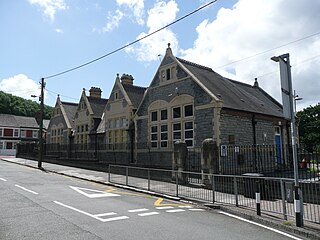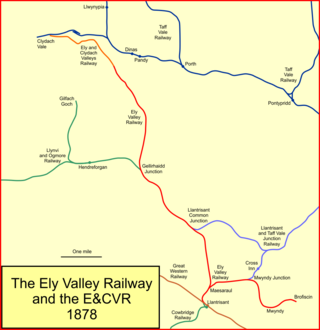
Until 1974, Glamorgan, or sometimes Glamorganshire, was an administrative county in the south of Wales, and later classed as one of the thirteen historic counties of Wales. Originally an early medieval petty kingdom of varying boundaries known in Welsh as Morgannwg, which was then invaded and taken over by the Normans as the Lordship of Glamorgan. The area that became known as Glamorgan was both a rural, pastoral area, and a conflict point between the Norman lords and the Welsh princes. It was defined by a large concentration of castles.

Tiger Bay was the local name for an area of Cardiff which covered Butetown and Cardiff Docks. Following the building of the Cardiff Barrage, which dams the tidal rivers, Ely and Taff, to create a body of water, it is referred to as Cardiff Bay. Tiger Bay is Wales’ oldest multi-ethnic community, with sailors and workers from over 50 countries settling there from the mid-19th century onwards.

The Taff Vale Railway (TVR) was a standard gauge railway in South Wales, built by the Taff Vale Railway Company to serve the iron and coal industries around Merthyr Tydfil and to connect them with docks in Cardiff. It was opened in stages in 1840 and 1841.

Penarth is a town and community in the Vale of Glamorgan, Wales, approximately 3 miles (4.8 km) south of Cardiff city centre on the west shore of the Severn Estuary at the southern end of Cardiff Bay.

From 1839 the Trustees of the Marquis of Bute, operated a large dock operation in Cardiff, the "Bute Docks". This was very successful, but was overwhelmed by the huge volume of coal exported through Cardiff. At the same time it was seen that railway companies, especially the Taff Vale Railway (TVR), were making money conveying the coal to the docks.
The Rhymney Railway (RR) was a railway company in South Wales, founded to transport minerals and materials to and from collieries and ironworks in the Rhymney Valley of South Wales, and to docks in Cardiff. It opened a main line in 1858, and a limited passenger service was operated in addition.

The Vale of Glamorgan Line is a commuter railway line in Wales, running through the Vale of Glamorgan from Barry to Bridgend, via Rhoose and Llantwit Major.

Grangetown railway station is a railway station serving the Grangetown district of Cardiff, Wales. It is located on the Vale of Glamorgan Line 1 mile (1.5 km) south west of Cardiff Central towards Bridgend via Barry, Penarth and Barry Island.

Penarth railway station is the railway station serving the town of Penarth in the Vale of Glamorgan, South Wales. It is the terminus of Network Rail's Penarth branch running from Cogan Junction to Penarth station, 1 mile 12 chains from the junction and 2 miles 67 chains south of Cardiff Central station. The Penarth branch ran from Cogan Junction to Biglis Junction, a rail mileage of 5 miles 65 chains and was officially closed beyond Penarth after the last passenger train ran on Saturday 4 May 1968.

Radyr railway station is a railway station serving the Radyr area of Cardiff, South Wales. It is at the foot of the hill at the eastern edge of the village, alongside the River Taff and adjacent to the Taff Trail. The station is on the Merthyr Line, and is also the northern terminus of the City Line.

Cadoxton railway station is a railway station serving Cadoxton and Palmerstown near Barry, Vale of Glamorgan, South Wales. It is located on the Barry Branch 6½ miles (10 km) south of Cardiff Central. The line continues to the terminus of the Barry Branch at Barry Island but from Barry Junction the line also continues as the Vale of Glamorgan branch to Bridgend via Rhoose for Cardiff International Airport bus link and then Llantwit Major.

The Barry Railway Company was a railway and docks company in South Wales, first incorporated as the Barry Dock and Railway Company in 1884. It arose out of frustration among Rhondda coal owners at congestion and high charges at Cardiff Docks as well the monopoly held by the Taff Vale Railway in transporting coal from the Rhondda. In addition, the Taff Vale did not have the required capacity for the mineral traffic using the route, leading to lengthy delays in getting to Cardiff.

Cogan is a suburb of Penarth in the Vale of Glamorgan, Wales 2.5 miles (4 km) south of the centre of the Welsh capital city of Cardiff. Cogan contains one of the vale's four major leisure centres.

The timeline of Cardiff history shows the significant events in the history of Cardiff which transformed it from a small Roman fort into the modern capital city of Wales.
The Llantrisant and Taff Vale Junction Railway was a railway company that constructed a standard gauge line in South Wales, connecting Llantrisant and the Taff Vale Railway near Treforest. It ran through thinly populated country, and linked to a number of iron mines, collieries and other mineral sites. It opened in stages in 1863 and 1864. In 1865 through passenger trains from the Cowbridge Railway ran over the line, to Pontypridd, although for some time there were no passenger stations on its own network. At the Llantrisant end, it was reliant on broad gauge railway companies which were not always friendly to it. The company leased its line to the Taff Vale Railway in 1870.

Cardiff Docks is a port in southern Cardiff, Wales. At its peak, the port was one of the largest dock systems in the world with a total quayage of almost 7 mi (11 km). Once the main port for the export of South Wales coal, the Port of Cardiff remains active in the import and export of containers, steel, forest products and dry and liquid bulks.

Barry Docks is a port facility in the town of Barry, Vale of Glamorgan, Wales, a few miles southwest of Cardiff on the north shore of the Bristol Channel. The docks were opened in 1889 by David Davies and John Cory as an alternative to the congested and expensive Cardiff Docks to ship coal carried by rail from the South Wales Coalfield. The principal engineer was John Wolfe Barry, assisted by Thomas Forster Brown and Henry Marc Brunel, son of the famous engineer Isambard Kingdom Brunel.

The Ely Valley Railway (EVR) was a broad gauge railway company in South Wales, which opened a mineral line between Llantrisant station on the South Wales Railway main line and pits at Mwyndy and Penrhiwfer in 1860.

Harriet Windsor-Clive, Baroness Windsor was a landowner and wealthy benefactor in the Penarth and Cardiff area of South Wales. She is probably best known for developing Penarth Dock in competition with the Marquess of Bute's docks in Cardiff and for her charitable donations in the area. A daughter of the 5th Earl of Plymouth, she was granted the title 13th Baroness Windsor in 1855 after the deaths of her sister and brother.






















